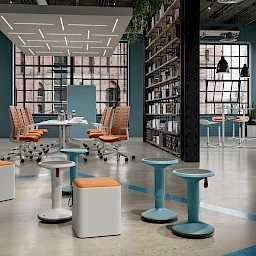We are living in increasingly complex times. The dependencies within our work activities are growing. Generalists are having a harder time of it, because a very high degree of specialization has become indispensable.
Of course, one option that is widely used makes the description of processes, workflows and responsibilities as detailed as possible so that they can be controlled. Well, in most cases the only target is manageability, with an interest in optimization (of the costs). By contrast, if you include the people who are affected and give them an opportunity to expand their perspective, you come up with genuine efficiency that has nothing to do with bookkeeping.
SOME AREAS ARE INCREASINGLY TRYING TO ACHIEVE BETTER RESULTS BY MEANS OF GAMIFICATION … IN OTHER WORDS, BY INSERTING GAME ELEMENTS INTO AREAS OF ACTIVITY THAT ARE NOT RELATED TO GAMES.
The British computer-game expert Richard Bartle coined the term “gamification” back in 1978, but the idea only began to be seriously implemented in 2012, especially in the USA.
HOW CAN YOU ENVISAGE IT?
The typical use cases are in the following areas:
Employee training:
- By adjusting the pace of learning in training sessions and regulating the degree of difficulty, training courses (just like games) can be adapted to the individual user. This improves the individual learning process.
- The term EPICSAVE stands for “Enhanced ParamedIC vocational training with Serious Games and Virtual Environments”. It’s a serious game simulation approach that is based on VR technology and aims to prepare trainee emergency paramedics for emergencies for which it’s practically impossible to train them in any other way.
- GaBa_LEARN – Game Based Learning in Nursing.
Consumer oriented applications:
- Bonus programmes, small game units, apps. Bonus point systems aimed at increasing customer loyalty to a certain supplier: bonus points in supermarkets, frequent flyer programmes, the »token economy«.
- Motivation and communication.
Sales and production:
- Leaderboards: the performance of individual employees or teams is compared with the performance of others. This is a justifiably controversial process, because the winners and the losers are played off against one another. Competition is promoted rather than cooperation and collaboration.
Health-sector applications:
- Insurance companies try to motivate the insured parties by means of cashback programmes.
Recruiting:
- »Recruitainment« by the French railway company SNCF: over a period of six months, job applicants had to perform tasks that included designing a train, using big data for the design process, and creating a concept for a new metro system for one million travellers.
Criticisms
However, there is no universal or standardized concept, because the different targets depend on the context of their application. As a result, persuading managers and employees to accept gamification processes is usually a very challenging task.
Another point of criticism is the in-depth recording of all the activities of the employees, because these data are used as the basis for distributing rewards. This creates a »transparent employee«.
If gamification is used in the wrong way, positive effects may be only short-lived or may not occur at all. Over time, the players become accustomed to certain rewards, and as a result the rewards lose their motivational effect.
Some players don’t abide by the prescribed rules. If there is an opportunity to cheat within the gamified system in order to receive more rewards, this will happen.
but all of these objections are actually water under the bridge.
let´s transfer gaming principles and a game environment to a setting that has nothing to do with games.
how did we play when we were kids?
Most of the time we adopted the perspective of an overview.
A toy train set was controlled in “God mode”, and problems were detected at an early stage.
Admittedly, when we were kids we tended to build the problems into the game. We would put a matchbox car, or our siblings’ soft toy, on the railroad tracks. In fact, this kind of gamification opens up a new perspective and calls on us to think in a multi-perspective way.
Imagining yourself on a construction site. Controlling the crane, dump truck, excavator etc. from above is very efficient. Every construction vehicle can be remotely controlled. The only thing is that the human being (still) stands to the side and stares at the sky.
During the pandemic we had the initial proofs of concept that demonstrated how this multimodal and interoperable form of remote robotics can work with the help of a VR or MR environment. Incidentally, in China such concepts have already been used in the mining industry for quite a while, just without VR. Modern agriculture could also work in exactly this way.
Game concepts such as The Settlers, Sim City and others could be used in real life to control digital twins. In the USA there are test installations in which the air traffic controller no longer has to stare at his radar screen. Instead, he’s looking down at the airport from above. Walking “around the gaming table” with his colleagues in order to see his work from different viewpoints. Thanks to support from prediction models and pattern recognition, human beings are largely relieved of routine work and can concentrate on the actual job at hand. Some functions could also operate partially or even entirely autonomously. After all, the game master is keeping an eye on everything.
We are in the process of creating a different kind of working.
there an expert could even work from home while still wearinf pyjamas.
Jay Latta is a technology strategist, visionary and investor with over 35 years of experience in industry, information technology and innovation. The keynote speaker also works internationally as a tech journalist and has built up his own think tank. He is passionate about cross-innovation and analysing complex technologies and systems, clearly defining actionable insights and helping C‑suites implement effective technology solutions. More information on Jay Latta can be found here.
Cover photo: ©AdobeStock_488891056, uthradamgraphics




 Jay Latta
Jay Latta 


